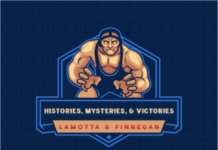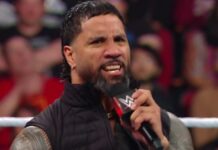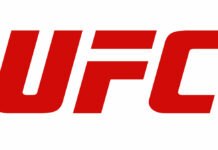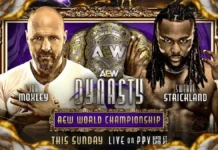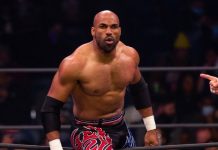Survivor Series, the second longest-running pay-per-view event behind only Wrestlemania, will air live this Saturday on Peacock. The streaming service is far away from the initial broadcast of either closed circuit in its earliest editions in the late–80s or calling jammed phone lines to order the show in the 90s. Despite watching this event on Peacock for this review, the 1992 edition of the show was actually one of the first WWF VHS tapes I had, as I remember my dad bought it for me, and according to the sticker that is still on the box, it was a used copy for $4.97. The Coliseum Video release opened with Revered Slick preaching about Thanksgiving, but for whatever reason, that introduction isn’t included on Peacock. That’s one of the downsides of more or less everything going digital within the massive WWE library. While it’s amazing to have such easy access to thousands of hours of wrestling content, there are certain portions of events that sometimes don’t make the switch to the streaming service, seemingly with no reasoning behind why some edits are made and some edits aren’t for the digital presentation. That’s why as antiquated as it might seem, I will always be a proponent of physical media in some form or fashion since it’s the only way to truly ensure access on a regular basis, especially when you don’t know who could end up with the distribution rights of the WWE Network and what edits they might make to the catalog.
Anyway, the show opened with The Headshrinkers vs. High Energy, the brief combination of Owen Hart and Koko B. Ware. Complete with parachute pants and suspenders, this was more or less a thrown together duo after Jim Neidhart was fired earlier in the year. This bout only went about six minutes, but for what it was, it was a solid opening segment. Samu and Fatu, despite their size, could keep up with their faster opponents and it allowed for some good exchanges. It’s somewhat disappointing that The Headshrinkers were still being used as the stereotypical savage tag team at this point because make no mistake about it, these guys can go in the ring. Afa was at ringside snacking on a turkey leg before he used a bamboo stick to whack Koko behind the referee’s back. The finish saw Samu land an impressive top rope splash on Owen to get the victory. If there was given more time, I think it could’ve been an even better match, but as mentioned, this had roughly six minutes, which wasn’t enough time for the contest to get into second gear.
A match that went only five minutes, but probably should’ve been given even less time on the broadcast was Nailz vs. The Big Bossman in a nightstick on a pole match. Of course, this first competitor to get the stick can use it. The Nailz character lasted less than a year and was only brought into the company to feud with Bossman, with this being the payoff to the storyline. Infamously, Nailz had a confrontation with Vince McMahon a few weeks after this pay-per-view and was fired from the company. However, given the character and the conclusion of the angle, I’m not sure there was really anything left for the persona to do in the organization in terms of storylines. To say the match was bowling shoe ugly would be charitable. Ray Traylor was known for being agile for his size and relatively light on his feet, but there wasn’t much he could do with this cement mixer of an opponent. The pace and almost every spot of this short bout was very clunky. The only redeeming quality of this segment was Bossman sold very well. Eventually, Bossman got the nightstick and delivered two shots to Nailz before the villain was able to get control of the stick to land two shots of his own. A miscue from Nailz allowed Bossman to hit his signature slam to get the pin before a final shot with the nightstick set his foe tumbling through the ropes to the floor. The only positive that you can really point out in this match is that they protected the nightstick gimmick. Each wrestler was only hit with it twice instead of a dozen times, which would dilute the effectiveness of the gimmick. Again, this was only five minutes, but seemed like a marathon to sit through this segment.
Rick Martel vs. Tatanka was a contest that I expected more from, to be honest. Martel is probably underrated and doesn’t get the credit he deserves because his main event stint in the AWA earlier in his career was during the latter stages of the organization. He had solid stints in the WWF and then his comeback run in WCW was cut short after an injury in 1998. Tatanka had somewhat of an odd career path in some ways because he was booked for an extended undefeated streak upon his arrival in the company in the early-90s and looked to fit what the organization wanted to present in that era to soften the image of the brand, but for whatever reason, he never got passed a lower mid-card spot. After a few years in the WWF he more or less disappeared from main stream wrestling until he had a comeback run in the WWE around 2006. The match itself was rather basic, nothing great and nothing subpar. It was just an average match that didn’t really stand out from the rest of the card with a deliberate pace that looked to work the crowd more than to provide in-ring action. Tatanka got the win to reclaim his eagle feathers.
Speaking of underwhelming, Razor Ramon and Ric Flair vs. Macho Man and Mr. Perfect was promoted as one of the featured bouts on the card, donning the front cover of the original box art, but it fell short of expectations, especially given the legendary talent in the match. Originally, The Ultimate Warrior was supposed to team with Randy Savage, but had left a few weeks earlier because of yet another dispute with management. Don’t get me wrong, the action was fine with some good exchanges between the participants at different points, but it just didn’t reach a level where it would be considered a main event bout. If I had to guess, one of the reasons might’ve been that Curt Hennig hadn’t wrestled for over a year at that point because of a serious back injury so perhaps ring rust was a factor. The finish didn’t do the segment any favors when Macho and Perfect won via a very flat disqualification.
Yokozuna beat Virgil in a two-minute squash match so there’s not much to discuss about it.
The Natural Disasters and The Nasty Boys beat Money Inc. and The Beverly Brothers in a traditional Survivor Series match. Despite all of the participants, this was basically the same eight-man tag formula that you’d see on home video releases during this era as a way to provide a “special event” for exclusive content on the VHS presentation. However, this is an opportunity to discuss why these types of matches were the original selling point of the Survivor Series concept on pay-per-view and also why an entire card of multi-man matches had to be scaled down to usually one signature match on a broadcast. Keep in mind, when the Survivor Series debuted on pay-per-view in 1987, it was during the squash match era that had potentially one featured match with stars on weekly television, but the dynamics of the business were still designed to sell tickets to local house shows. In a similar fashion, the Survivor Series concept allowed fans to see an entire night of stars compete against each other when it wasn’t common place on WWF TV. When more stars competed against each other as the TV product evolved, an entire show of eight-man tag matches was too repetitive so they scaled down the original concept.
The Undertaker beat Kamala in a casket match. This only went about five minutes and won’t get seven stars, but it was really entertaining for what it was. The vignettes of The Undertaker building the custom casket for Kamala were memorable and one of the many examples of how The Undertaker portrayed the character better than anyone else could’ve done it. Kamala wasn’t Lou Thez, but he was one of the most memorable characters because of how well he worked the gimmick and could add different aspects to it through the years. For example, the cannibalistic persona from a decade earlier in Mid-South had the mannerisms and body language to look like a legitimate threat to the top baby faces in the territory. By 1992, taking into account the direction of the company, Kamala was more of a cartoon and he presented that dynamic well too so he was undoubtedly a versatile performer. His over-the-top expressions and being afraid of the casket, while cartoonish, were well done in terms of the presentation.
The main event was the newly-minted WWF champion Bret Hart defending against Shawn Micheals in a match that more or less saved the show as far as in-ring quality. It’s ironic that these two took center stage at this point because they would more or less be the centerpieces in the aftermath of the steroid scandal and be used as a part of the “new generation” to help repair the image of the company. You can tell that these two are still developing their main event styles that they would use regularly in the years that followed, but this is a really solid match. It was more than twenty minutes of fast-paced action, and everyone was crisp and smooth. Micheals bumped all over the place to make the champion look strong, and the crowd was behind the action as the momentum tilted back and fourth during the contest. Eventually, Bret Hart got the submission with the sharpshooter to retain the championship.
Overall, this pay-per-view was essentially a product of its era and thus seems rather subpar now, outside of the main event. The matches that had potential to deliver in-ring action were too short to get to the next level, and the flat DQ finish in the tag match hindered the presentation of star power on the show.. The main event is definitely worth watching, but the vast majority of this show is skippable because of the lack of quality on the card.
What do you think? Share your thoughts, opinions, feedback, and anything else that was raised on Twitter @PWMania and Facebook.com/PWMania.
Until next week
-Jim LaMotta
E mail [email protected] | You can follow me on Instagram, Facebook, & Threads @jimlamotta89


